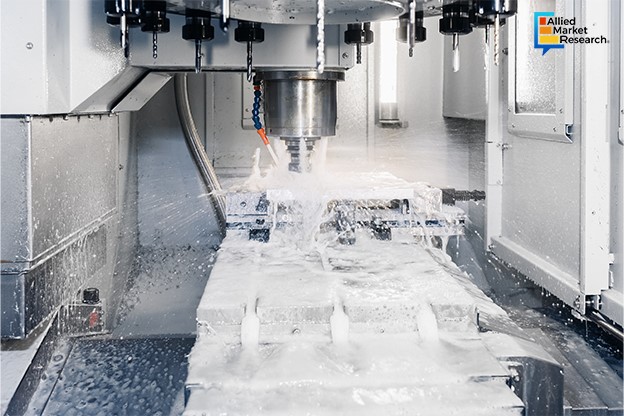Why Fiberglass Cutting Robots Have Gained Popularity in the Industrial Sector?

9 May
2024
Highlights
- Introduction
- Trends in the fiberglass cutting robots industry
- New product launches in the sector
In recent years, robotics technology has made remarkable progress, with improvements in accuracy, precision, and path-planning algorithms. These advancements have driven the development of advanced fiberglass cutting robots capable of handling complex cutting patterns and achieving superior results.
Fiberglass cutting robots are automated systems with the latest cutting tools and programming abilities, enabling them to execute precise and efficient cuts on fiberglass materials. These robots provide several benefits compared to traditional manual cutting methods, such as enhanced speed, accuracy, consistency, and heightened worker safety.
In challenging environments, such as aerospace facilities, construction sites, warehouses, and manufacturing plants, heavy payload robots are used due to rise in demand for handling substantial loads. Heavy payload robots offer adaptability to varied payloads, the ability to work in diverse industries such as automotive, marine, aerospace, & wind energy, and precision cutting abilities. Owing to these factors, the heavy payload segment is projected to hold an absolute revenue of $12,953.4 million by 2032.
Advanced fiberglass cutting robot trends shape the future of the industry
Automation technology enhancements fuel rise in demand for fiberglass-cutting robots in the industry. As industrial processes increasingly prioritize accuracy and efficiency, robots specialized in cutting fiberglass have gained importance. This trend underscores the shift of the industry toward automated solutions to boost productivity and enhance quality control measures.
Integration of Cloud technology in operation
In the future, robots cutting fiberglass are estimated to be powered by cloud-based technologies. Cloud solutions offer remote programming and monitoring capabilities, facilitating data analysis and control. This trend is expected to be advantageous for manufacturers as it simplifies robot operation, streamlines preventative maintenance procedures, and facilitates improved real-time cutting process.
Advent of Cobots
Traditional fiberglass cutting robots faced limitations in smaller workshops due to their cost and size. However, cobots have revolutionized this landscape. With their lightweight build and user-friendly nature, these robots collaborate safely with humans, providing greater adaptability and seamless integration into existing processes. The adoption of cobots is expected to gain popularity in the fiberglass-cutting robot industry, particularly for tasks involving precise cuts and shapes.
Integration of advanced vision system
The industry has witnessed an increase in integration of advanced vision systems and robotics. These devices automatically adjust cutting trajectories using real-time data gathered from cameras and sensors placed on fiberglass layout. This enhances accuracy and enables the handling of material imperfections & evolving process designs.
Analyzing the fiberglass cutting robots sector across the LAMEA region
Industrialization and urbanization in developing nations across the LAMEA region, such as Brazil and South Africa, boost the expansion of the fiberglass cutting robots industry. The rise in industrial output and the surge in demand for automation in these emerging economies foster the adoption of fiberglass-cutting robots. Among the developing countries of LAMEA, Africa is anticipated to cite a noteworthy CAGR of 11.1% during the forecast period.
Recent developments in the the sector
The global fiberglass cutting robots sector has transformed due to high investments in R&D, lack of skilled workforce, high labor cost, and high need for automation. Top players in the industry have adopted novel strategies to strengthen their presence in the dynamic industry. For instance, ABB introduced two new versions of its GoFa cobot, the GoFa 12 and GoFa 10 in June 2023. These models are designed to provide companies with additional opportunities to utilize cobot automation for increased efficiency. With the ability to lift loads of up to 10 kg and 12 kg while maintaining repeatability, these cobots perform a wider range of tasks in close collaboration with factory workers.
To conclude, fiberglass cutting robots provide several benefits compared to traditional manual cutting methods, such as enhanced speed, accuracy, consistency, and heightened worker safety. Enhancements in automation technology fuel a rise in demand for fiberglass cutting robots in the industry. Moreover, top players discover new products with advanced features to sustain the dynamic industry.
Contact us for future estimations and competitive analysis of the global fiberglass cutting robots industry.

Koyel Ghosh
Author’s Bio- Koyel Ghosh is a blogger with a strong passion and enjoys writing in miscellaneous domains, as she believes it lets her explore a wide variety of niches. She has an innate interest in creativity and enjoys experimenting with different writing styles. A writer who never stops imagining, she has been serving the corporate industry for the last five years.
3 Latest Underground Mining Vehicle Technologies in Which Mining Corporations Are Actively Investing
Avenue: Entire Library membership of Allied Market Research Reports at your disposal
- Avenue is an innovative subscription-based online report database.
- Avail an online access to the entire library of syndicated reports on more than 2,000 niche industries and company profiles on more than 12,000 firms across 11 domains.
- A cost-effective model tailored for entrepreneurs, investors, and students & researchers at universities.
- Request customizations, suggest new reports, and avail analyst support as per your requirements.
- Get an access to the library of reports at any time from any device and anywhere.
Related Post
-
How are Submarine Cables Transforming Global Connectivity with Enhanced User Experience?
-
Endoscopy Procedures: Transformations in Techniques and Applications
-
AI-Powered Video Analytics: How the Product Actually Works for enterprises
-
Painting Robots: Transforming Precision Coating and Creative Applications
-
Innovations in Pharmacovigilance Systems Advancing Patient Safety
-
Understanding Edge Security: Keeping Data Safe Near the Source
-
Exploring the Use and Advancements of 3D Laser Scanners in Professional Applications
-
Reinforcing Industrial Controls with Smarter Tools and Training








